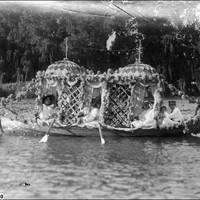Event
ContributeOn Christmas Eve 1910 the Chronicle newspaper reported that ‘never before has our pretty little river Torrens presented such a brilliant and charming appearance as it did on Saturday [17 December]’ when the first Henley-on-Torrens Regatta was held. In homage to the Henley-on-Thames Regatta in Oxfordshire, United Kingdom and inspired by the Henley-on-Yarra Regatta that had recently become popular in Melbourne, Mr E Doswell of the Adelaide Rowing Club had proposed this festival event of decorated boats and feats of rowing skill. The Register reported that the South Australian Rowing Association hoped that the carnival would ‘draw to the riverside many people who would not be attracted by a racing programme alone’. The event was a resounding success. Despite considerable differences between the wide and deep Yarra and the ‘dear little stream’ of the Torrens, as the Chronicle noted, the ‘matter was thought out well, and the idea materialised charmingly’ on the day.
The summer day was somewhat overcast, but this did not hinder the enjoyment of the crowds who made their way along the new paths and over the velvety green grassy banks to the rowing clubhouses on the riverside. Rowing races were held throughout the day, with tough competition in the contest for the Webb Memorial Cup and in the Public Schools Race with St Peters College facing Port Pirie High School. During a break in racing in the afternoon, thousands of spectators assembled to watch the carnival procession of ornately decorated pleasure craft. ‘One after the other the artistically and effectively decorated boats made their appearances, the saucy breezes occasionally catching the decorations and keeling them perilously to one side’ recorded the Chronicle.
The procession of boats, and an afternoon of tea and music
The procession of boats was led by the mayoral launch, Defiance, with Lord Mayor Lewis Cohen and members of the City Council aboard. The Defiance was decorated with ‘a charming floral scheme of scarlet poppies and butterflies mingled with fern asparagus’. Then came two row boats covered in wheat ears and poppies, with ladies aboard in matching poppy-laden white hats. Many other boats came in ever more elaborate designs. One of the most popular and artistic was Mr Doswell’s boat, covered in flowers shading from pale yellow to deep orange, topped with an enormous white swan.
Cash prizes were awarded for the best and most ornamental boat designs, and the fashions of the day were noted. Of particular interest to the Chronicle were the women wearing the new style ‘tub frocks’, less formally structured dresses in modern, machine-washable fabrics, that ‘struck a much more harmonious note than the damsel who tripped down in the glories of silk and satin’.
Afternoon tea served to the huge crowd at the Adelaide Rowing Clubhouse was accompanied by fluttering flags in lines along the path and music in the air. The celebrations and mingling continued for hours with the Orpheus Society playing from the balcony of the clubhouse and a brass band performing in the Elder Park Rotunda.
Undercurrents
However, beneath the frivolity of the day was a serious note. Several boats for the procession had been stranded at Port Adelaide because of a South Australian Drivers Union protest at labour conditions and wage rates. According to the Advertiser, the transport workers were the ‘worst paid workers in the State’. The drivers’ strike, which had been going on for some days, also interrupted the supply of electricity for lighting the evening for the regatta. The Chronicle commented a little snidely, ‘the electric light festoons were conspicuous in their absence, owing to a little unpleasantness in the workman’s world’.
Despite the problem, the boats and crowds made do with other forms of illumination, and the sight of lighted boats drifting up and down the river in the light of the full moon was ‘restful and satisfying’.
Regattas over the years
The Henley-on-Torrens Regatta immediately became one of the most popular events of the Adelaide calendar. Boat decorations were incredibly ornate, and teams spent months preparing them. Patriotic themes were often included in the designs, particularly during wartime. The glamour and charm surrounding the regatta even saw British starlet Sabrina visit when in Adelaide with her new stage show in 1959.
The tradition of the Henley-on-Torrens Regatta continues in the twenty-first century. Adelaide Rowing Club hosted the event in November 2014, and it proved an exciting day of racing. The regatta commenced early in the morning and featured a new obstacle: the new and as-yet unnamed Torrens footbridge. Rowers commenced racing from beneath the Morphett Street Bridge, before proceeding under the new bridge (which featured neon lights on its side to indicate racing lanes) and finishing about 50 metres beyond it. The current Henley-on-Torrens course is named for Adelaide native Kate Slatter OAM, who is widely regarded as the most successful female rower in Australian history.
Media
Add mediaImages

Image courtesty of the State Library of South Australia, SLSA: PRG 280/1/24/55, Public Domain

Image courtesy of the State Library of South Australia, SLSA: PRG 280/1/30/153, Public Domain

Image courtesy of the State Library of South Australia, SLSA: PRG 280/1/40/32, Public Domain



CommentAdd new comment
Quickly, it's still quiet here; be the first to have your say!